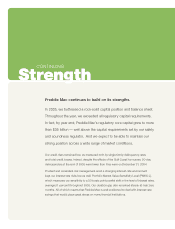Freddie Mac 2005 Annual Report Download - page 18
Download and view the complete annual report
Please find page 18 of the 2005 Freddie Mac annual report below. You can navigate through the pages in the report by either clicking on the pages listed below, or by using the keyword search tool below to find specific information within the annual report.
Residential Mortgage Debt Market
We compete in the large and growing U.S. residential mortgage debt market. This market consists of a primary
mortgage market that links homebuyers and lenders, and a secondary mortgage market that links lenders and investors. At
December 31, 2005, our Total mortgage portfolio was $1.7 trillion, while the total U.S. residential mortgage debt
outstanding was estimated to be approximately $9.9 trillion.
The residential mortgage market has grown substantially in recent years, as low interest rates and a strong housing
market have resulted in record levels of mortgage loan originations, including reÑnancings of existing residential mortgage
debt. As interest rates have increased, reÑnancings have declined. Throughout 2005, short-term interest rates increased
signiÑcantly as a result of the actions of the Board of Governors of the Federal Reserve System, or the Federal Reserve,
which regulates the supply of money and credit in the U.S.; however, the Federal Reserve's actions had less of an impact on
long-term interest rates. Consequently, the slope of the ""yield curve'' Ì or the spread between short-term and long-term
interest rates Ì continued to Öatten throughout the year. Despite the rise in interest rates, mortgage rates remained low by
historical standards and continued to contribute to demand in the residential mortgage market.
As indicated in Table 1, house prices appreciated nationwide at a rate of approximately 13 percent in 2005 with some
regional variation. However, this appreciation rate is expected to moderate. Total residential mortgage debt outstanding in
the U.S. grew at an estimated annual rate of 14 percent in both 2005 and 2004. We expect the amount of total residential
mortgage debt outstanding will continue to rise in 2006, though at a slower rate than in the past few years.
Table 1 Ì Mortgage Market Indicators
Year-Ended December 31,
2005 2004 2003
Home sale units (in thousands)(1) ÏÏÏÏÏÏÏÏÏÏÏÏÏÏÏÏÏÏÏÏÏÏÏÏÏÏÏÏÏÏÏÏÏÏÏÏÏÏÏÏÏÏÏÏÏÏÏÏÏÏÏÏÏÏÏÏÏÏÏÏÏÏÏÏÏÏ 7,462 7,162 6,529
House price appreciation ÏÏÏÏÏÏÏÏÏÏÏÏÏÏÏÏÏÏÏÏÏÏÏÏÏÏÏÏÏÏÏÏÏÏÏÏÏÏÏÏÏÏÏÏÏÏÏÏÏÏÏÏÏÏÏÏÏÏÏÏÏÏÏÏÏÏÏÏÏÏÏÏÏÏ 13% 12% 8%
Single-family mortgage originations (in billions) ÏÏÏÏÏÏÏÏÏÏÏÏÏÏÏÏÏÏÏÏÏÏÏÏÏÏÏÏÏÏÏÏÏÏÏÏÏÏÏÏÏÏÏÏÏÏÏÏÏÏÏÏÏÏ $2,828 $2,911 $3,860
ARM share of single-family mortgage originations ÏÏÏÏÏÏÏÏÏÏÏÏÏÏÏÏÏÏÏÏÏÏÏÏÏÏÏÏÏÏÏÏÏÏÏÏÏÏÏÏÏÏÏÏÏÏÏÏÏÏÏÏ 31% 34% 19%
ReÑnancing share of single-family mortgage originations ÏÏÏÏÏÏÏÏÏÏÏÏÏÏÏÏÏÏÏÏÏÏÏÏÏÏÏÏÏÏÏÏÏÏÏÏÏÏÏÏÏÏÏÏÏÏÏ 44% 46% 65%
U.S. residential mortgage debt outstanding (in billions)(2) ÏÏÏÏÏÏÏÏÏÏÏÏÏÏÏÏÏÏÏÏÏÏÏÏÏÏÏÏÏÏÏÏÏÏÏÏÏÏÏÏÏÏÏÏÏÏ $9,851 $8,642 $7,581
(1) Includes sales of new and existing detached single-family homes in the U.S. and excludes condos/co-ops. Source: National Association of Realtors
news release dated May 25, 2006 (sales of existing homes) and U.S. Census Bureau news release dated May 24, 2006 (sales of new homes).
(2) Debt outstanding at year-end, not seasonally-adjusted. Source: Federal Reserve Flow of Funds Accounts of the United States dated June 8, 2006.
Growth in the U.S. residential mortgage debt market is aÅected by several factors, including changes in interest rates,
employment rates in various regions of the country, home ownership rates, house price appreciation, and borrower
preferences concerning the portion of his or her home's value to Ñnance with mortgage debt. The amount of residential
mortgage debt available for us to purchase and the mix of available loan products are also aÅected by several factors,
including the volume of single-family mortgages within the loan limits imposed under our charter and the purchase and
securitization activity of other Ñnancial institutions. See ""RISK FACTORS.''
Primary Mortgage Market Ì Our Customers
Our customers are predominantly lenders in the primary mortgage market that originate mortgages for homebuyers.
These lenders include mortgage banking companies, commercial banks, savings banks, community banks, credit unions, state
and local housing Ñnance agencies, and savings and loan associations. A lender that originates a mortgage can either hold
the mortgage in its own portfolio, securitize the mortgage or sell the mortgage to a secondary mortgage market investor, such
as Freddie Mac.
We buy a signiÑcant portion of our mortgages from several large mortgage lenders. During 2005, three mortgage lenders
each accounted for 10 percent or more of our mortgage purchase volume and in the aggregate they accounted for
approximately 47 percent of this volume. These three lenders are among the largest mortgage loan originators in the United
States. We have contracts with a number of mortgage lenders, including some large lenders, that include a commitment by
the lender to sell us a minimum percentage or dollar amount of its mortgage origination volume. These contracts typically
last for one year. If a mortgage lender fails to meet its contractual commitment, we have a variety of contractual remedies,
including the right to assess certain fees. As the mortgage industry has been consolidating, we, as well as our competitors,
have been seeking business from a decreasing number of key lenders. See ""RISK FACTORS Ì Competitive and Market
Risks.'' We are working to diversify our customer base and thus reduce the risk of losing a key customer.
Secondary Mortgage Market
We participate in the secondary mortgage market generally by buying whole loans (i.e., mortgage loans that have not
been securitized) and mortgage-related securities for our Retained portfolio and by issuing guaranteed mortgage-related
securities. We do not lend money directly to homebuyers. Our principal competitors are the Federal National Mortgage
Association, or Fannie Mae, a similarly chartered government-sponsored enterprise, or GSE, the Federal Home Loan Banks,
2Freddie Mac
























